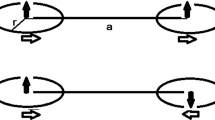Abstract
The equality between the spontaneous magnetization and the “long range order” is established for the Ising model with nearest neighbour interactions for low and high temperatures. The proof is presented for the two-dimensional lattice but works also in higher dimensions. The result verifies that the valuem*=(1−(Shβ)−4)1/8 of the spontaneous magnetization below the critical point calculated by Onsager and Yang is the true value, which has been a long standing open question.
Similar content being viewed by others
References
Fisher, M.E.: Phys. Rev.162, 480 (1967).
Gallavotti, G., Miracle-Solé, S.: Equilibrium states of the Ising model in the two phase region. Preprint 1971.
Ginibre, J.: Proc. Cargése Summer School 1969. New York: Gordon and Breach 1971.
—— Commun. math. Phys.16, 310 (1970).
Griffiths, R.: Phys. Rev. A136, 437 (1964).
—— Phys. Rev.152, 240 (1966).
—— J. Math. Phys.8, 478, 484 (1967).
Kelley, D., Sherman, S.: J. Math. Phys.9, 466 (1968).
Lebowitz, J., Martin-Löf, A.: On the uniqueness of the definition of the critical temperature for Ising ferromagnets. Preprint 1971.
Ruelle, D.: On the use of “small external fields” in the problem of symmetry breakdown in statistical mechanics. Preprint 1971.
Author information
Authors and Affiliations
Rights and permissions
About this article
Cite this article
Martin-Löf, A. On the spontaneous magnetization in the Ising model. Commun.Math. Phys. 24, 253–259 (1972). https://doi.org/10.1007/BF01878475
Received:
Issue Date:
DOI: https://doi.org/10.1007/BF01878475



